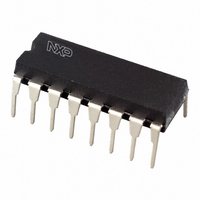74HC191N,652 NXP Semiconductors, 74HC191N,652 Datasheet - Page 2

74HC191N,652
Manufacturer Part Number
74HC191N,652
Description
IC COUNTER UP/DOWN SYNC 16DIP
Manufacturer
NXP Semiconductors
Series
74HCr
Datasheet
1.74HC191N652.pdf
(14 pages)
Specifications of 74HC191N,652
Package / Case
16-DIP (0.300", 7.62mm)
Logic Type
Binary Counter
Direction
Up, Down
Number Of Elements
1
Number Of Bits Per Element
4
Timing
Synchronous
Count Rate
39MHz
Trigger Type
Positive Edge
Voltage - Supply
2 V ~ 6 V
Operating Temperature
-40°C ~ 125°C
Mounting Type
Through Hole
Logic Family
74HC
Number Of Bits
4
Operating Supply Voltage
2 V to 6 V
Operating Temperature Range
- 40 C to + 85 C
Mounting Style
Through Hole
Lead Free Status / RoHS Status
Lead free / RoHS Compliant
Reset
-
Lead Free Status / Rohs Status
Lead free / RoHS Compliant
Other names
568-1412-5
74HC191N
933669460652
74HC191N
933669460652
Philips Semiconductors
FEATURES
GENERAL DESCRIPTION
The 74HC/HCT191 are high-speed Si-gate CMOS devices
and are pin compatible with low power Schottky TTL
(LSTTL). They are specified in compliance with JEDEC
standard no. 7A.
The 74HC/HCT191 are asynchronously presettable 4-bit
binary up/down counters. They contain four master/slave
flip-flops with internal gating and steering logic to provide
asynchronous preset and synchronous count-up and
count-down operation.
Asynchronous parallel load capability permits the counter
to be preset to any desired number. Information present on
the parallel data inputs (D
and appears on the outputs when the parallel load (PL)
input is LOW. As indicated in the function table, this
operation overrides the counting function.
Counting is inhibited by a HIGH level on the count enable
(CE) input. When CE is LOW internal state changes are
initiated synchronously by the LOW-to-HIGH transition of
the clock input. The up/down (U/D) input signal determines
the direction of counting as indicated in the function table.
The CE input may go LOW when the clock is in either
state, however, the LOW-to-HIGH CE transition must
occur only when the clock is HIGH. Also, the U/D input
should be changed only when either CE or CP is HIGH.
December 1990
Synchronous reversible counting
Asynchronous parallel load
Count enable control for synchronous expansion
Single up/down control input
Output capability: standard
I
Presettable synchronous 4-bit binary
up/down counter
CC
category: MSI
0
to D
3
) is loaded into the counter
2
Overflow/underflow indications are provided by two types
of outputs, the terminal count (TC) and ripple clock (RC).
The TC output is normally LOW and goes HIGH when a
circuit reaches zero in the count-down mode or reaches
“15” in the count-up-mode. The TC output will remain
HIGH until a state change occurs, either by counting or
presetting, or until U/D is changed. Do not use the TC
output as a clock signal because it is subject to decoding
spikes. The TC signal is used internally to enable the
RC output. When TC is HIGH and CE is LOW, the RC
output follows the clock pulse (CP). This feature simplifies
the design of multistage counters as shown in Figs 5
and 6.
In Fig.5, each RC output is used as the clock input to the
next higher stage. It is only necessary to inhibit the first
stage to prevent counting in all stages, since a HIGH on
CE inhibits the RC output pulse as indicated in the function
table. The timing skew between state changes in the first
and last stages is represented by the cumulative delay of
the clock as it ripples through the preceding stages. This
can be a disadvantage of this configuration in some
applications.
Fig.6 shows a method of causing state changes to occur
simultaneously in all stages. The RC outputs propagate
the carry/borrow signals in ripple fashion and all clock
inputs are driven in parallel. In this configuration the
duration of the clock LOW state must be long enough to
allow the negative-going edge of the carry/borrow signal to
ripple through to the last stage before the clock goes
HIGH. Since the RC output of any package goes HIGH
shortly after its CP input goes HIGH there is no such
restriction on the HIGH-state duration of the clock.
In Fig.7, the configuration shown avoids ripple delays and
their associated restrictions. Combining the TC signals
from all the preceding stages forms the CE input for a
given stage. An enable must be included in each carry
gate in order to inhibit counting. The TC output of a given
stage it not affected by its own CE signal therefore the
simple inhibit scheme of Figs 5 and 6 does not apply.
74HC/HCT191
Product specification














